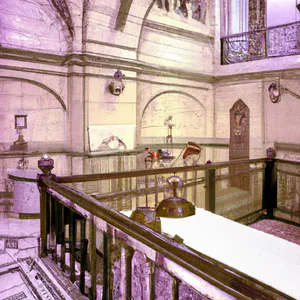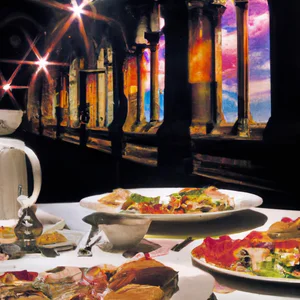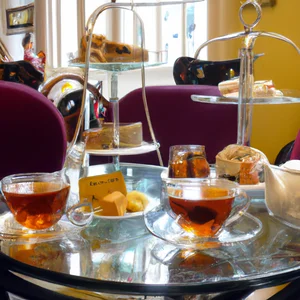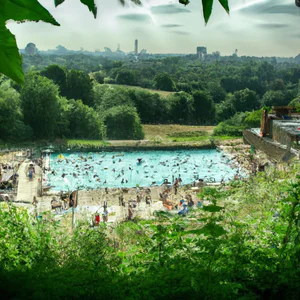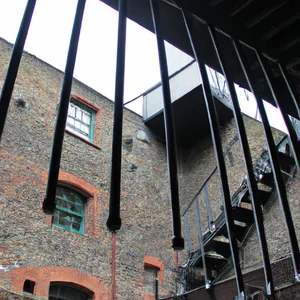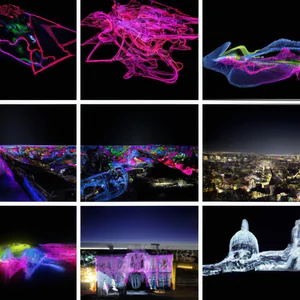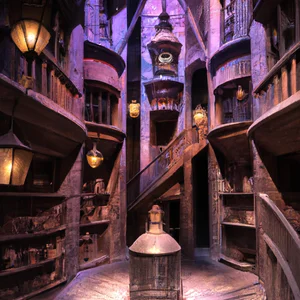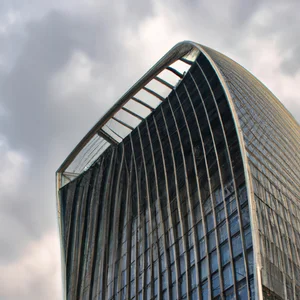Book your experience
Darwin Center (Natural History Museum): Science and architecture come together in a glass cocoon
Darwin Center at the Natural History Museum: there, science and architecture embrace each other in a sort of glass cocoon that is truly something special.
When I first went, wow, it was like entering a giant greenhouse full of natural wonders! The structure is completely transparent, and it almost seems like being inside a bubble, where the outside world disappears and you feel surrounded by nature. It’s as if the glass is telling you: “Hey, look at how many secrets our planet has to offer!”.
And then, sorry to tell you, but the way it’s designed is really brilliant. The shapes, the curves… it almost seems as if the building wants to tell you its story, like an open book. The light that enters from every corner makes you feel part of everything, as if we were all here discovering the mysteries of life together.
To tell the truth, as I walked through the exhibits, I had a moment of reflection. I think it’s amazing how science and art can come together so harmoniously. I don’t know, maybe it’s a little poetic, but it made me think about how important it is to preserve what surrounds us. In a certain sense, the Darwin Center is not just a place of exhibition, but a sort of reminder to all of us to take care of our planet.
I mean, if you think about it, who would have ever thought that a museum could have such a welcoming and stimulating atmosphere? It makes you want to explore, to discover, to ask questions! And, I mean, who doesn’t love a little trivia? So, if you’ve never been, I recommend you stop by. You might even get inspired, who knows?
A journey through glass: the architecture of the Darwin Centre
A personal anecdote
I remember perfectly the moment I walked through the doors of the Darwin Centre, located inside the prestigious Natural History Museum in London. Light filtered through the enormous glass walls, creating an almost ethereal atmosphere that seemed to transport me to another dimension. In that moment, I felt part of a vibrant ecosystem, where science and architecture intertwine in an almost poetic way. The structure, with its innovative design, is not just a place of learning, but a work of art that celebrates the biodiversity of our planet.
Practical information
The Darwin Center opened in 2009 and is an integral part of one of the world’s most important natural history museums. Its architecture, designed by the Hawkins\Brown architecture firm, is characterized by a glass envelope that not only allows natural light to illuminate the interior spaces, but also symbolizes the transparency of science. If you’re planning a visit, the museum is open daily from 10am to 5.50pm and entry is free, although it’s advisable to book in advance for special events or interactive workshops.
An insider tip
A tip that few people know is to take advantage of the guided tours conducted by museum experts. These tours offer exclusive access to sections not generally open to the public and can provide a unique perspective on the Darwin Centre’s architecture and collections. Be sure to book in advance, as places are limited!
Cultural and historical impact
The fusion of science and architecture in the Darwin Center is not just an aesthetic question. It reflects a cultural commitment to environmental education and awareness. This space is a beacon for scientific research and a center of attraction for visitors of all ages, contributing to a crucial dialogue on biodiversity conservation.
Sustainability in architecture
A notable aspect of this center is its commitment to sustainability. The use of eco-friendly materials and the design oriented towards energy efficiency reduce the environmental impact of the structure. During your visit, you will see how the Darwin Center strives to be an example of sustainability, encouraging visitors to reflect on their daily practices.
Immersive experience
Imagine walking along the glass cocoon, with the light dancing on the scientific specimens on display. The interactive routes will allow you to explore biodiversity in an engaging and visually stimulating way. I advise you not to miss the opportunity to participate in one of the interactive workshops, where you can touch the objects (literally!) and find out more about the scientific research underway.
Myths to dispel
A common misconception is that the Darwin Center is just a place for children. In fact, the variety of exhibits and in-depth science make it fascinating for adults and families. It is a place where curiosity is always welcome and science is presented in an accessible and fascinating way.
Final reflection
As you leave the Darwin Centre, take a moment to reflect on how interconnected science and nature are. Next time you look at a tree or an animal, ask yourself: What is the story behind it? This center is not just a place to visit, but an invitation to explore and better understand the world around us. Are you ready to embark on this journey into glass and biodiversity?
Discover biodiversity: exhibitions not to be missed
An Unforgettable Experience
I still vividly remember the moment I crossed the threshold of the Darwin Centre at the Natural History Museum in London. The air was thick with anticipation, and my heart pounded as I stood before one of the most fascinating exhibits: the biodiversity of our planet. Among the specimens of flora and fauna, I felt like an explorer discovering a new world, with each display telling stories of life and adaptation. It is an experience that stimulates not only the mind, but also the heart.
Exhibitions not to be missed
The Darwin Centre is a true cradle of biodiversity, where the visitor can immerse themselves in extraordinary exhibitions such as the one on reptiles and amphibians, which highlight the importance of these creatures in our ecosystem. Don’t forget to visit the section dedicated to insects, with rare specimens that show the beauty and complexity of life around us. According to the museum’s official website, these exhibits are curated by experts and often updated to reflect the latest scientific discoveries.
Insider advice
If you want a truly unique experience, take part in one of the special guided tours held at unconventional times. These tours offer exclusive access to sections normally closed to the public and allow you to interact with curators, who share never-before-seen anecdotes and fascinating details about the exhibitions.
Cultural and Historical Impact
The Darwin Centre is not just a place of exhibition, but a beacon of knowledge and awareness about biodiversity and its importance. Its construction and innovative design reflect the values of Charles Darwin, whose work revolutionized the way we understand life on Earth. Through exhibits, visitors can appreciate Darwin’s legacy and the need to protect our planet.
Sustainability in Action
The center is actively committed to sustainability, promoting practices that reduce environmental impact. The structure itself is designed to be eco-friendly, using sustainable materials and energy-saving technologies. Visiting the Darwin Center is therefore also a way to support environmental education.
Immerse yourself in the Atmosphere
Walking among the exhibitions, it is impossible not to be fascinated by the exotic beauty of the plants and animals, displayed in an environment that almost seems like a botanical garden. The soft lighting and contemporary design create a serene, encouraging atmosphere contemplation and wonder.
A Recommended Activity
After exploring the exhibitions, I recommend taking part in one of the interactive workshops organized at the centre. Here, you will not only have the opportunity to learn more about biodiversity, but also to actively contribute to ongoing research projects.
Myths to dispel
It is common to think that the Darwin Center is just a place for science experts. In fact, it is accessible and fascinating for everyone, regardless of knowledge level. The exhibits are designed to engage visitors of all ages, making science fun and understandable.
A Final Reflection
At the end of my visit, I asked myself: what small steps can we take in our daily lives to protect the biodiversity we have been lucky enough to explore? The Darwin Center is not just a showcase of natural wonders, but an invitation to reflect and act for the good of our planet.
Close encounters with science: interactive workshops at the Darwin Centre
An experience that leaves its mark
I still remember my first visit to the Darwin Centre, when I found myself face to face with a group of enthusiastic students, all looking through a microscope. Their wonder was contagious, and I found myself snooping around too, exploring the invisible world around us. At that moment, I understood that this is not just a museum, but a true laboratory of discoveries. The close encounters with science here are an opportunity not just to observe, but to interact and learn.
Practical information
The Darwin Center offers a range of interactive workshops designed for all ages, where visitors can try hands-on activities, such as analyzing biological samples or creating models of organisms. The sessions are led by experts and are available by reservation. For further details and to check availability, it is advisable to visit the official website of the Natural History Museum of London.
An insider tip
A little-known tip is to attend workshops on weekdays, when the number of visitors is smaller. This will allow you to have a more intimate experience and to ask questions to the educators without rushing. Also, don’t forget to ask if there are special sessions dedicated to specific topics, such as the conservation of endangered species, which are often less publicized but incredibly engaging.
The cultural and historical impact
The Darwin Center is not just a place of learning; it is an innovation center that celebrates scientific research. Through the workshops, visitors come into contact with discoveries that have shaped our understanding of life on Earth. The opportunity to work closely with scientists and conservators offers a unique insight into ongoing research, something that not only enriches cultural heritage but also stimulates interest in scientific careers.
Sustainability and responsibility
The Darwin Center is actively committed to sustainability. Part of the workshop activities include ecological practices and respect for the environment, educating visitors on the importance of biodiversity conservation. This approach not only makes the experience educational but also contributes to forming responsible and aware citizens.
Immersion in the atmosphere
Imagine entering a laboratory crowded with colors and sounds, where the scent of scientific materials mixes with the excitement of learning. The laughter of children, the curious questions of adults and the palpable energy of young scientists create an atmosphere that is as inspiring as it is welcoming. Every corner of the Darwin Center is designed to inspire, and the interactive workshops are the beating heart of this experience.
An activity worth trying
I recommend you try the DNA extraction lab, where you can see and manipulate the genetic material of fruits like strawberries. It’s an activity that leaves a lasting impression and offers a fascinating glimpse into what makes us unique.
Myths to dispel
A common misconception is that labs are only for budding scientists or students. In fact, everyone, regardless of age or experience, can benefit from these activities. The Darwin Center is a place where curiosity is celebrated, and anyone has the chance to become a “scientist for a day”.
A final reflection
Next time you think about a museum visit, consider immersing yourself in the Darwin Centre’s interactive workshops. What could the world of science reveal to you that you have never considered before? Curiosity is the first step towards discovery, and the Darwin Center is the perfect stage to begin this journey.
Narratives of a Bygone Era: Forgotten Museum Stories
A journey through the pages of history
When I visited the Darwin Center for the first time, I found myself in front of a glass case containing a specimen of an ancient species of fish, the Coelacanth. I remember thinking: this fish has survived millions of years of evolution, but who knows its history? This is the charm of the Darwin Centre: it’s not just about displays of biodiversity, but about forgotten stories that reveal the richness of life on Earth and the evolution that shaped it.
Discover forgotten stories
The museum is not just a place of exhibition, but a living archive of historical narratives. Every specimen, every fossil, every diorama tells a chapter of our natural history. The collection of scientists such as Alfred Russel Wallace and Charles Darwin bear witness to an intellectual struggle that forever changed our understanding of life. Speaking with the curators, I learned that many pieces in the collection were saved from catastrophic historical events, such as wars and natural disasters, making each of them a silent witness to a bygone era.
An insider tip
If you would like to delve deeper into these stories, ask to take part in one of the thematic guided tours, often led by industry experts. These visits are not always advertised, but they offer a unique opportunity to explore lesser-known aspects of the museum, revealing details you wouldn’t find in audio guides.
The cultural and historical impact
The Darwin Center is not just a museum, it is a monument to science and human curiosity. Its influence extends far beyond the center’s walls, inspiring generations of scientists and natural history enthusiasts. Through its exhibitions, the museum continues to stimulate discussions on sustainability and conservation, addressing current challenges facing our planet.
Sustainability and responsibility
In an era where responsible tourism is more important than ever, the Darwin Center adopts sustainability practices, such as the use of eco-friendly materials in its exhibitions and the organization of educational events to raise public awareness of environmental issues. Participating in these initiatives can be a way to contribute to a greater cause while immersing yourself in history.
An experience not to be missed
Don’t miss the opportunity to explore the forgotten stories of the Darwin Center through an interactive activity: the paleontology laboratory, where you can try to discover real fossils and reconstruct their history. It’s a practical way to connect with narratives of the past, experiencing firsthand what it means to be a researcher.
Myths and misconceptions
It is common to think that museums are static and boring places, but the Darwin Center proves this wrong this idea. Each visit is a dynamic and engaging experience, full of discoveries and surprises. The forgotten stories that lie within its walls are vivid and pulsating, ready to be told.
Final reflection
As you leave the Darwin Centre, ask yourself: How many forgotten stories surround us in everyday life? Every corner of our planet is loaded with narratives just waiting to be discovered. This museum is not just a place of exhibition, it is an invitation to explore and rediscover our connection to the history of life on Earth.
Sustainability in action: the center and the environment
Visiting it was an enlightening experience: the Darwin Centre, with its glass walls that reflect natural light, is a tangible example of how architecture can marry with sustainability. I remember walking along the corridors, while the light filtered through the transparent panels, creating a play of shadows and colors that seemed to dance around me. Each step brought me closer not only to science, but also to a more conscious way of thinking about our environment.
A concrete commitment to the environment
The Darwin Center is not only a place for scientific exhibitions, but also represents a model of sustainability. Thanks to the use of green technologies, such as rainwater collection systems and thermal insulation, the center significantly reduces its environmental impact. This commitment is supported by local initiatives, such as the “Greener Museums” campaign promoted by the Natural History Museum, which aims to make the institution an example of eco-compatibility.
An insider tip
If you want to live a unique experience, try taking part in a sustainability workshop organized by the centre. These events will not only allow you to learn practical techniques to reduce your ecological footprint, but will also give you the opportunity to interact with industry experts. Times and dates may vary, so it is advisable to check the museum’s official website for updated information.
A cultural heritage to be preserved
The Darwin Center is a beacon of knowledge and research that builds on a tradition of exploration and discovery. Sustainability is not just a modern goal, but a historical necessity that resonates with the work of Charles Darwin himself, who taught us the importance of understanding and respecting our environment. His legacy lives on through the center, which continues to educate and inspire visitors of all ages.
Sustainable tourism practices
When visiting the Darwin Centre, consider using public transport to get there. London’s transport network is well developed, and traveling by train or bus not only reduces your environmental impact, but also gives you the opportunity to discover hidden corners of the city. Another way to contribute is to purchase sustainable souvenirs at the museum shop, where you can find responsibly made products.
An immersive experience
Imagine entering one of the exhibition rooms, surrounded by models of marine and terrestrial ecosystems. Each object tells a story of biodiversity and interconnection. We invite you to experience a guided tour, where experts will accompany you through the wonders of nature, revealing details that you could easily miss on your own.
Myths to dispel
A common misconception about science museums is that they are boring and uninteractive places. In contrast, the Darwin Center has embraced technology, offering interactive workshops and immersive exhibitions that engage visitors in unexpected ways. It is not just a place of learning, but an environment where curiosity can explode in every corner.
In conclusion, the next time you visit the Darwin Centre, we invite you to reflect on how everyday choices can contribute to the sustainability of our planet. What steps could you take to live more responsibly and consciously? The real discovery, in the end, may not only be scientific, but also personal.
Exclusive tip: Visit at sunset for a magical experience
Imagine standing in front of the glittering façade of the Darwin Centre, as the sun begins to dip over the horizon, painting the sky in shades of orange and pink. I still remember the first time I visited the center in the late afternoon; that magical moment, when the artificial lights turn on and the glass architecture lights up, creating an almost surreal atmosphere. It is an experience that cannot be described, but only lived.
A unique experience
For those who want to enjoy this amazing view, I highly recommend planning your visit for sunset. Hours vary depending on the season, so it’s worth checking the Natural History Museum’s official website for the most up-to-date information. During the evening hours, the flow of visitors is reduced, leaving room for a more intimate and contemplative atmosphere.
An insider tip that few people know is that, during sunset, you can see wildlife coming to life in the surrounding gardens. With a bit of luck, you might spot woodpeckers and squirrels, while birdsong fills the air. This is a valuable opportunity to connect with biodiversity, a central theme of the Darwin Centre.
The cultural value of the sunset
The choice to visit the Darwin Center at sunset is not just a question of aesthetics; it is also a way to reflect on the legacy of Charles Darwin and his deep connection with nature. Watching the light change as day turns to night offers a new perspective on the work of Darwin, who dedicated his life to understanding the wonders of the natural world.
Sustainability and responsibility
In an era where sustainability is at the center of discussions, the Darwin Center is a prime example of how modern architecture can integrate with the environment. During your sunset visit, take the opportunity to reflect on how it is possible to travel responsibly and respectfully towards biodiversity.
Soak up the atmosphere
As you approach the structure, let yourself be enveloped by the architectural wonder. The glass and steel of the Darwin Center reflects the sunset light in a way that inspires wonder. Every corner of the center tells a story, and as the sun goes down, these stories intertwine with the natural beauty that surrounds you.
A special activity to try
To make your visit even more memorable, bring along a notebook and pen. Take a moment to write down your reflections or draw what you see. This simple gesture will allow you to connect more deeply with the experience and take home a tangible memory of your encounter with science and nature.
Final reflections
Many may think that a visit to the Darwin Center is just a daytime activity, but the sunset experience offers a new dimension to this science icon. I invite you to consider: How can a simple time change transform your perception of a place? Discovering the Darwin Center at sunset could prove to be an unforgettable moment in your trip, full of wonder and introspection.
Local experiences: coffee and culture nearby
A coffee that tells stories
I vividly remember the moment I discovered a little café just a short walk from the Darwin Centre, the Museum Café. Upon entering, the air was permeated with the enveloping scent of roasted coffee beans and freshly baked pastries. The shelves were adorned with books on biodiversity and the adventures of Charles Darwin, creating an atmosphere that invites reflection. During my visit, I sat at a table near the window, while the sun was slowly setting, illuminating the glass of the Darwin Center with golden hues. It was a moment of pure magic, where science and culture intertwined in a sublime way.
Practical information
The Museum Café is open daily from 8am to 6pm and offers not only great coffees, but also vegetarian and vegan options. If you’re looking for a light lunch, don’t miss their quinoa and avocado salad, which is as nutritious as it is delicious. For up-to-date information on special offers and events, you can visit their website or follow their social pages.
An insider tip
A little-known tip is to ask the barista at the Museum Café to prepare you a Darwin coffee, an exclusive recipe that mixes different extraction methods, creating a unique experience for coffee lovers. This is a perfect way to pay homage to the great scientist while enjoying your drink.
A cultural bond
The area around the Darwin Center is a crossroads of culture and history. Local cafés are not just places to refresh, but also meeting spaces for scientists, students and natural history enthusiasts. This exchange of ideas and knowledge is rooted in a tradition that dates back to Darwin’s time, when scientific debate often took place in cafés and living rooms.
Sustainability and responsible tourism
Many of these cafés, including Museum Café, employ sustainable practices, such as using organic and local ingredients, and reducing waste through the use of compostable materials. Choosing to eat and drink in these places not only supports the local economy, but also contributes to more responsible tourism.
An atmosphere to explore
Imagine sitting on an outdoor table, surrounded by greenery and art, while you sip a cappuccino and plan your visit to the Darwin Centre. The atmosphere is vibrant and inspiring, perfect for inspiring your curiosity about biodiversity and the natural world.
An activity not to be missed
If you have time, join one of the guided tours offered by some of the local coffee shops, where you can explore not only the gastronomy, but also the art and culture of the neighborhood. These tours will take you to discover hidden corners and fascinating stories that you might otherwise miss.
Myths and misconceptions
There is a common myth that the best dining experiences are only found in high-end restaurants. In reality, many of the most authentic and interesting cafes are found in less conventional places, where the soul of the city is reflected in the food and drinks served.
A final reflection
When you think about a trip, how much space do you give to the local experience? Discovering the cafes and culture around the Darwin Center isn’t just a refreshing break; it’s an opportunity to connect with the history, science, and people that make this place so special. What is your favorite cafe in a destination you have visited?
A corner of research: the role of the Darwin Centre
A personal experience
I vividly remember the moment I walked through the door of the Darwin Centre. An air of curiosity and discovery hovered among the visitors, all attracted by the wonder of biodiversity that unfolded before their eyes. As I admired the glass structure that seemed to blend into its surroundings, I felt an irresistible urge to explore not only what was on display, but also what was happening behind the scenes. I was lucky enough to attend a seminar held by scientists who work at the center: an experience that transformed my view on science and conservation.
Practical information
Located within the Natural History Museum in London, the Darwin Center is a research hub dedicated to the study of biodiversity. Its state-of-the-art facilities house over 27 million samples, making it one of the most important research centers in the world. For those who wish to delve deeper, it is possible to take part in guided tours that offer an exclusive look at the research activities. Visit the Museum’s official website for updated information on opening times and reservations.
An insider tip
If you really want to immerse yourself in the world of research, try to book a place in one of the Open Research Laboratories. These events, often little publicized, offer a unique opportunity to interact with researchers and discover innovative projects, such as the DNA analysis of rare species or the monitoring of marine ecosystems. It’s a way to feel part of the scientific community, even just for a day.
The cultural impact
The Darwin Center is not just a workplace for scientists; it is a symbol of our commitment to biodiversity conservation. The presence of this center reflects the legacy of Charles Darwin and his lasting impact on the science and philosophy of life. His concept of adaptation and natural selection is more relevant than ever, inviting all of us to reflect on our role within the ecosystem.
Sustainability and responsibility
The structure of the Darwin Center itself is an example of sustainable architecture. Use advanced technologies to reduce energy consumption and environmental impact. Rainwater harvesting systems and natural lighting are just some of the practices that demonstrate a serious commitment to sustainable tourism. By visiting the center, you will not only admire science, but also support a model of responsible development.
An immersive atmosphere
When you enter the Darwin Centre, you are greeted by a brightness that conveys a sense of wonder. The glass walls convey a sense of openness, inviting natural light to dance between the spaces, while the green of the plants and the presence of rare specimens create an almost mystical atmosphere. This is a place where science meets beauty, and where every corner tells a story of research and discovery.
An activity worth trying
Don’t miss the opportunity to participate in an interactive workshop. Here you can watch scientists up close as they work and even participate in live experiments. It is an experience that will not only enrich you, but will make you feel part of an ongoing scientific adventure.
Myths to dispel
A common misconception is that the Darwin Center is just a natural history museum. In fact, it is a hub of active and innovative research. Don’t just think it’s just a place to visit; it is also a center where discoveries take place that can change the way we understand the world.
A final reflection
As you leave the Darwin Centre, I invite you to reflect: how can we all help preserve the biodiversity of our planet? Research and innovation are needed more than ever, and every small gesture can have a big impact. In this space of science and beauty, your connection to the natural world deepens, inviting you to become a conscious guardian of our fragile ecosystem.
A cultural icon: the connection with Charles Darwin
When I ventured into the Darwin Center for the first time, I couldn’t help but think of Charles Darwin and the impact he had on our understanding of life on Earth. As I wandered among the specimens of flora and fauna, I felt a strong connection to the innovative thinking of Darwin, a man who dared to challenge convention and who, with his theory of evolution, changed the course of science. Imagine finding yourself in the beating heart of a scientific era, surrounded by artifacts that tell stories of adaptation and survival.
A journey through time and space
The Darwin Center is not just a place where science comes to life; it is a real tribute to one of the greatest thinkers in history. The architecture itself, with its sinuous lines and glass walls, reflects the fluidity of the life that Darwin studied. Every corner of the building seems to capture the essence of his insatiable curiosity, inviting visitors to explore the wonders of biodiversity.
Advice for visitors
If you want to delve deeper into Darwin’s legacy, I recommend taking one of the thematic guided tours organized regularly by the museum. These experiences not only offer an overview of the exhibits, but also include fascinating stories about Darwin’s life and work. You may find, for example, that some of the samples collected during his Beagle voyage are on display right here!
A lasting cultural impact
The link between the Darwin Center and Charles Darwin goes beyond the simple display of artefacts. It has a significant cultural impact: the museum is a place of education and inspiration, where new generations can learn the principles of biology and ecology. Its mission to promote sustainability and conservation is a clear reminder of Darwin’s legacy, inviting us to reflect on the importance of protecting our planet.
Responsible tourism practices
Visit the Darwin Center knowing that you are participating in an initiative that promotes sustainability. The museum has implemented green practices, such as the use of renewable energy and environmental education programs, to ensure that Darwin’s message continues to live and inspire for decades to come.
One final thought
As I left the Darwin Centre, I found myself pondering a question: What would it mean for us today to embrace evolution not only as a biological process, but also as an invitation to evolve as a society? Every visit is an opportunity to renew our commitment to research and discovery, just as Charles Darwin did. If you ever find yourself in London, don’t miss the opportunity to explore this extraordinary place and discover the beauty of life through the eyes of a brilliant scientist.
Special events and temporary exhibitions: what not to miss
An unforgettable memory
I still remember the thrill I felt when I entered the Darwin Center for the first time and discovered a temporary exhibition dedicated to rainforest ecosystems. The vibrant sights and sounds of the jungle created an immersive atmosphere that seemed to transport me straight into the heart of nature. This is exactly what the Darwin Center offers: a journey through special events and temporary exhibitions that are as fascinating as they are educational. Each visit can reserve surprises, making each experience unique and memorable.
What to expect
The Darwin Centre, part of the Natural History Museum in London, is famous for its temporary exhibitions that explore topics of great scientific and cultural relevance. Currently, the “Ocean Giants” exhibition offers an unmissable opportunity to explore the world of large marine mammals, with interactive installations and fascinating exhibits. Special events, such as conferences with internationally renowned scientists and hands-on workshops, make the visit even more engaging. For updated information, I recommend checking the museum’s official website or social media pages, where upcoming events are posted.
An insider tip
A tip that few people know is to participate in the “Late Night Events” that the museum organizes during the summer. These evenings offer an exclusive experience with access to exhibitions, special nature-inspired cocktails and meetings with experts. It’s a fantastic way to discover the museum in a more intimate and relaxed atmosphere, away from the daytime crowds.
Cultural and historical impact
The Darwin Centre’s temporary exhibitions not only provide scientific information, but also insight into the ecological challenges we face today. Through events such as “Plastic Pollution: The Exhibition”, the museum raises public awareness of the impact of pollution. This educational mission is critical, as the museum strives to train a new generation of conservationists and scientists.
Sustainability in focus
An interesting aspect of the exhibitions is the emphasis on sustainability. Many events include discussions on responsible practices and innovative conservation solutions. The center works with local organizations to promote sustainable tourism, encouraging visitors to reflect on how their actions affect the environment.
A sensory immersion
Imagine walking through softly lit galleries, surrounded by art installations that tell stories of biodiversity and conservation. The combination of natural sounds and immersive videos will make you feel part of a vibrant ecosystem. Each exhibition is an opportunity to explore and discover, stimulating curiosity and love for nature.
An experience worth trying
Don’t miss the chance to participate in a hands-on workshop during your visit. These activities will allow you to interact directly with scientists and naturalists, deepening your knowledge on specific topics such as species conservation or marine ecology. It’s a great way to learn and actively contribute to an important cause.
Myths to dispel
A common misconception is that temporary exhibitions are only for children. In fact, the Darwin Center offers content that captures the interest of all ages, making science learning accessible and inspiring for all visitors. No matter what your age or background, you are sure to find something that fascinates you.
Final reflection
When thinking about your next trip, consider the importance of events like those offered at the Darwin Centre. Which nature story would impact you most? Each exhibit is an opportunity to reconsider our place in the world and our impact on the ecosystems around us. In a time when environmental awareness is more crucial than ever, the Darwin Center represents a beacon of knowledge and hope.

 Architecture and Design
Architecture and Design Cities and Regions
Cities and Regions Culture and History
Culture and History Events and Festivals
Events and Festivals Fashion and Shopping
Fashion and Shopping Food and Wine
Food and Wine Nature and Adventure
Nature and Adventure Unique Experiences
Unique Experiences


















